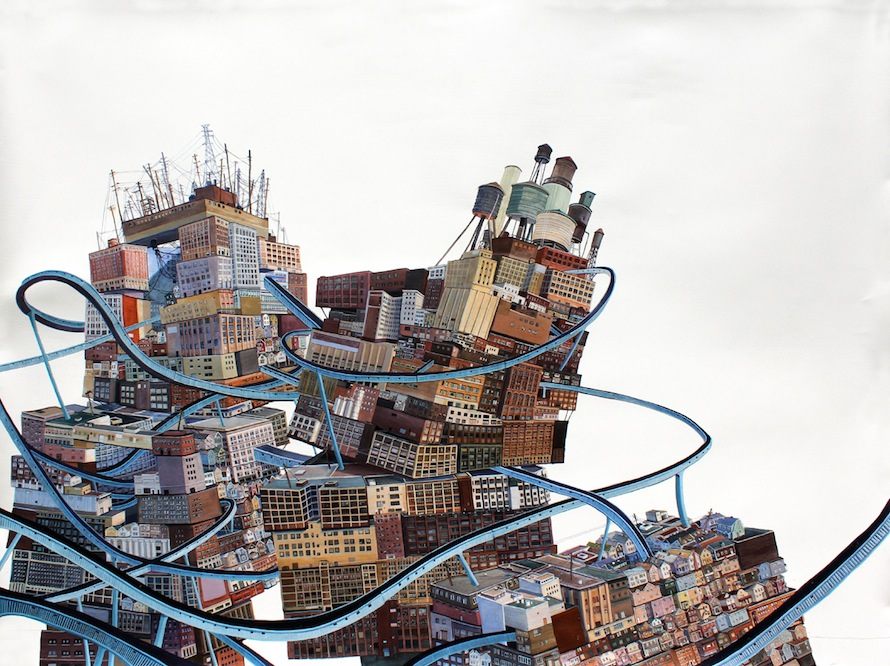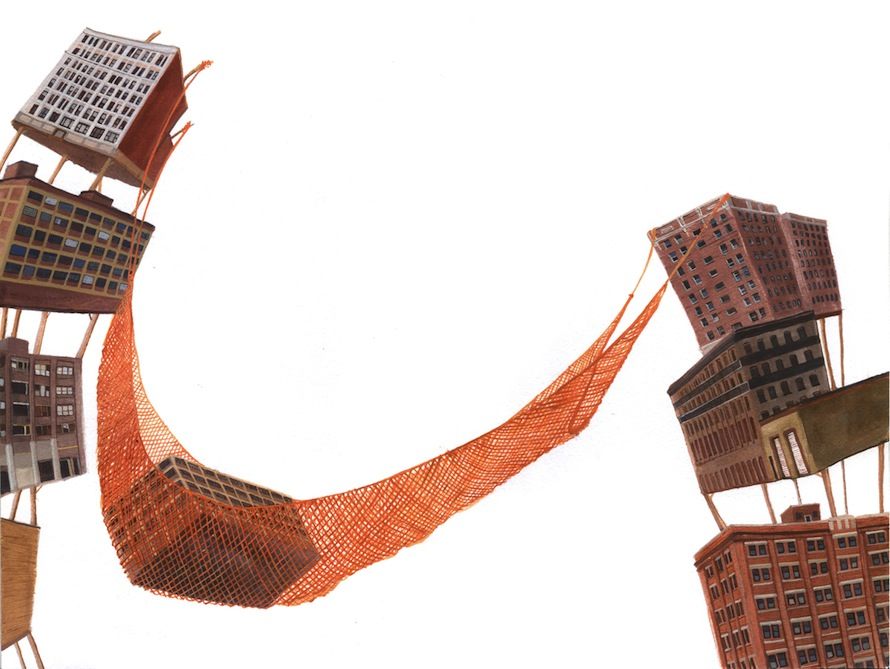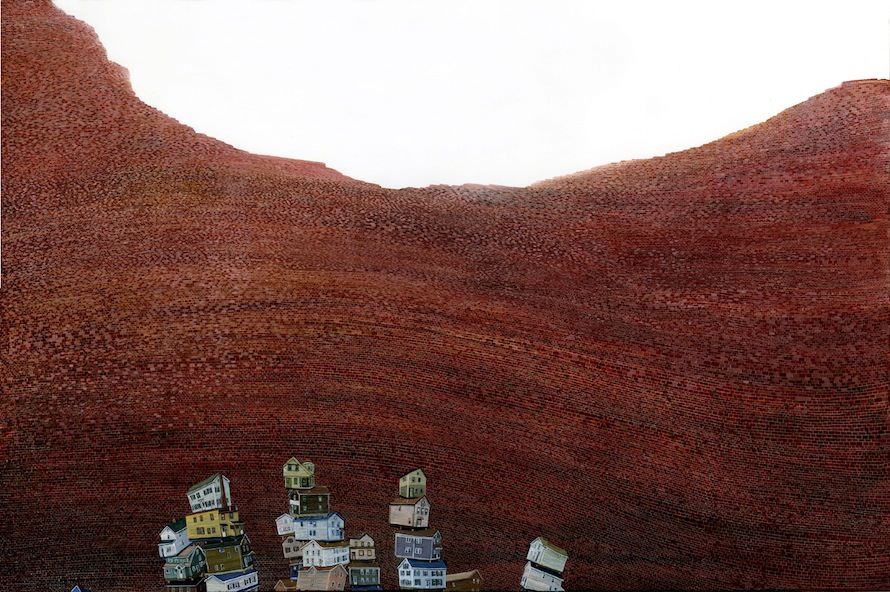Boomtown
The post-post-apocalyptic cityscape will see houses built in hammocks, and neighborhoods bound by chains. If you’ve ever felt that urban living depends on a wing and a prayer, welcome home.

Interview by Nicole Pasulka
TMN: What’s happening in this work?
Amy Casey: It’s a coming-together, growth, and celebration of cities and the struggles within.
TMN: Your paintings have long had a thematic and visual continuity. How have these ideas and images evolved for you over the years?
AC: I can watch the evolution of this work going back at least 11 years ago to when I was painting little creatures (often a kind of self-portrait) and their adventures in abstract settings with hints of things I saw around me in the city. Very different work, but it led me to questions and solutions about conveying urban life and cityscapes. Around 2005, I started a garden, and the Indian Ocean Tsunami had just happened at the tail of 2004, which I felt some particular angst about because I knew some people in South-east Asia. So these two new obsessions in my life diverged. Reflecting on my thoughts about our ultimate lack of control and how we all soldier on somehow.
I flooded my cities with strange alien-esque plants, which prompted me to find a solution to save the creatures. My work became a way to deal with my anxieties with the real world and what became an obsession with the news. So I tried to solve problems in my own universe. I set buildings on stilts (sometimes I like to imagine that way below my paintings is an angry mob of hungry plants, waiting) and this led to more problems (stilts snapping, etc.), which led to more solutions (ropes, etc.), which led to more problems (wind, etc.) which led to networks and sturdier building materials, etc., with various other fixes, jerry rigs, and plans along the way. And as I go, I tend to weave in reflections of things I see around me, or I get sudden flashes of imagery I just really want to see on paper, and that gets to be part of the world, too. I could not honestly say that I know where this is all leading—that is part of the interest for me—but I am sure that if it leads somewhere else entirely, then that is where I will go. Continue reading ↓
Boomtown is currently on view at Zg Gallery in Chicago. All images © the artist, all rights reserved.










Interview continued
TMN: I was in New Orleans after Hurricane Katrina, where rebuilding housing was a huge part of the recovery. Formations of houses have been a theme in your work for years. Why them in particular?
AC: I actually paint all sorts of structures, from houses to warehouses to a few high-rises and factories and hot dog restaurants, but most people do focus on the houses. Andm of course, that makes sense, considering nearly everyone has some experience with houses, and very deeply felt experiences at that. Houses to me are foremost part of the cityscape (and many of the homes I paint are from my own neighborhood in Cleveland), and a cityscape seems a little lifeless and bloodless to me without them. I also found that when I left off including creatures in the paintings, houses often lent a bit of humanity; they are easy for me to empathize with and sort of anthropomorphize. So they became the “creatures” in the paintings. Whenever people see my works as lifeless because I don’t put actual humans in them, I am always taken a little off guard, although I understand where they are coming from.
I did take some inspiration from the aftermath of Hurricane Katrina, along with some of the other various large disasters that were happening, natural and otherwise. The idea of insisting upon building and rebuilding in such vulnerable places, of taking what is left and building anew on top of the whole complicated history, is of great interest to me. I like the idea of hidden history in cities, and I like that I know the entire history of my own painted city.
TMN: Who lives here?
AC: Well, anyone could I suppose. The buildings in the paintings are all actual places, and so I usually think of the people I am familiar with living there, although obviously I can’t know all the people in all the buildings I paint, and no one outside of my neighborhood or the other places I’ve been could connect to that.
Part of the reason I shied away from painting actual people a long time ago was that I didn’t want the work to become about subgenres of people. People like me or people not like me. People who are of some particular age or race or size or tax bracket. I like to think that anyone could imagine living in, or, if they are afraid of heights, quickly getting a Uhaul and moving out of my paintings.
TMN: When I look at these paintings, I feel like I can see all this movement and hear these houses creaking. Is there action or movement in your mind when you’re painting them?
AC: Movement and composition have been a big part of my work, especially a few years ago when things were swishing through the air a lot more. Lately I have been focusing on trying to make things (relatively) more stable within the parameters of the universe I have created. I am sort of at the brick-house stage in the three little pigs story, so I think less about structures moving en masse, but rather movement around and within the cities.
TMN: Do you think you’ll continue painting these scenes?
AC: My work tends to move in a linear fashion; one idea leads to another, with some backtracking to re-investigate some possibilities or to tweak ideas. I can say in a general way, that I have gone from storytelling, which got too personal for me, to an interest in how things fall apart. Now I am more focused on growth, and how things come back together. I am not sure if they read this way, but that is how I approach them.
